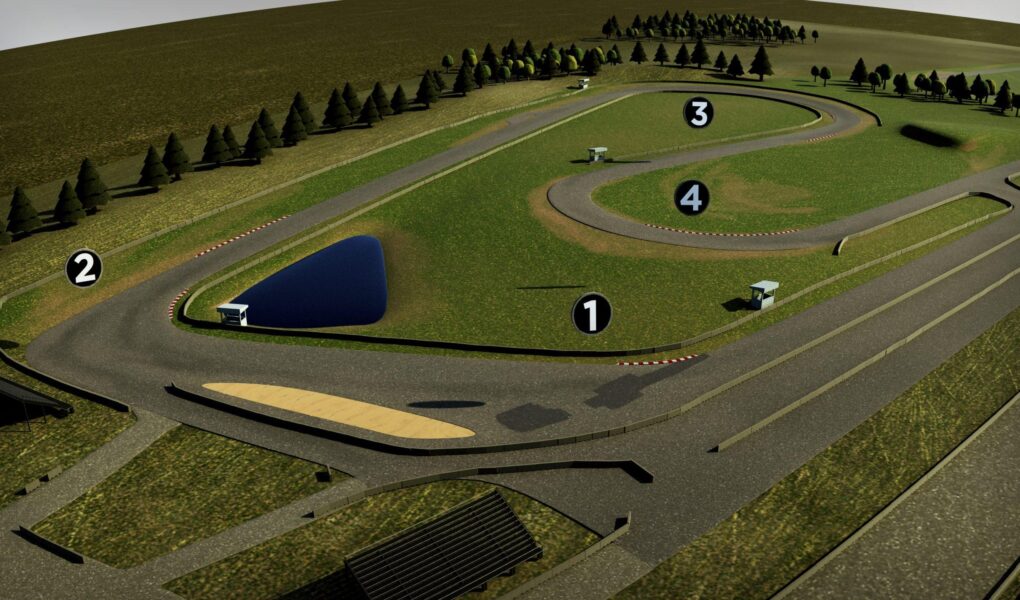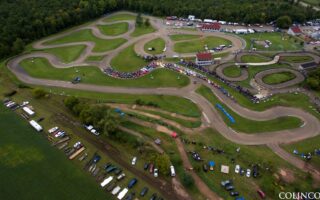Introduction to the World of Raceway Tracks
Imagine the thunderous roar of engines, the scent of burning rubber, and the exhilarating rush of speed that ripples through the air. A raceway track is not merely an arena for competition; it is a pulsating heart of passion, precision, and performance. From the winding curves of a road course to the straightaways of an oval, these tracks serve as a canvas where drivers and machines unite in a symphony of adrenaline and strategy. In this article, we will explore the fascinating intricacies of raceway tracks, delving into their history, design, and the myriad of events they host. Whether you’re a seasoned motorsport fan or a curious newcomer, join us on this journey through the vibrant world of racing, where every lap tells a story and every pit stop can change the course of a race.
Table of Contents
- Exploring the Anatomy of a High-Performance Raceway Track
- Design Essentials for Optimal Racing Experiences
- Safety Innovations in Raceway Track Engineering
- Maximizing Visitor Engagement at Raceway Events
- Q&A
- In Retrospect
Exploring the Anatomy of a High-Performance Raceway Track
Understanding the various components that contribute to the optimal performance of a raceway track is essential for both fans and professionals in the motorsport world. The layout is one of the most critical elements, consisting of a series of curves, straights, and elevation changes that challenge drivers’ skills and vehicle capabilities. Key elements of a high-performance track include:
- Curves: Designed to test cornering speeds.
- Straights: Allow drivers to maximize speed and overtake.
- Elevation Changes: Enhance difficulty and strategy.
Moreover, the track surface plays a vital role in performance. A high-quality surface provides the right balance of grip and durability, allowing for consistent lap times. Track conditions can fluctuate based on weather, so it’s crucial to monitor factors such as temperature, humidity, and wind speed. The track’s design must also accommodate safety features, including soft barriers and runoff areas, ensuring both driver safety and the excitement of the chase. A simple overview of important track features might look like this:
| Feature | Description |
|---|---|
| Surface Material | High-grip asphalt or concrete for optimal traction. |
| Runoff Areas | Designed to prevent collisions and allow vehicles to regain control. |
| Marshalling System | Essential for coordinating race starts and track conditions. |
Design Essentials for Optimal Racing Experiences
Creating an exhilarating racing experience is an art that blends functionality and aesthetics. The choice of materials for the track should prioritize durability while ensuring the safety of participants. Some essential considerations include:
- Surface Grip: A combination of asphalt or concrete mixed with aggregate to enhance traction, ensuring vehicles maintain control at high speeds.
- Elevation Changes: Introducing hills and dips can create thrilling challenges for racers and enhance the visual impact of the track.
- Water Drainage Systems: Proper drainage features to prevent flooding and maintain optimal surface conditions during races.
Additionally, the design of surrounding amenities plays a crucial role in the overall experience. Incorporating spectator areas, pit stops, and garages should consider:
- Viewing Platforms: Strategically placed grandstands that offer sweeping views of the track without obstructing the racing action.
- Accessibility Features: Ensuring that pathways and facilities cater to all attendees, including those with disabilities.
- Interactive Zones: Areas where fans can engage with racers, view vehicle displays, and participate in racing simulations.
| Element | Purpose |
|---|---|
| Safety Barriers | Protect drivers and spectators |
| Electronic Scoreboards | Enhance spectator engagement |
| Pit Area Design | Facilitate quick vehicle servicing |
Safety Innovations in Raceway Track Engineering
The world of raceway track engineering has witnessed a revolutionary transformation in safety measures over the years. Engineers and designers are now prioritizing the well-being of drivers and spectators by integrating advanced technology and innovative materials into track design. For instance, soft barriers and energy-absorbing crash cushions have become standard features, effectively mitigating the impact of collisions. Additionally, the incorporation of tech-enhanced monitoring systems, which utilize real-time data analytics, allows for immediate assessment of track conditions, enabling prompt responses to potential safety hazards.
Another significant advancement is the implementation of improved drainage systems that minimize water accumulation, thus reducing the risk of hydroplaning. Tracks are now designed with multi-layered surfaces that enhance grip while maintaining optimal tire performance in various weather conditions. Furthermore, the integration of LED lighting for night races not only improves visibility for drivers but also ensures enhanced safety for spectators. The efforts to fuse engineering precision with innovative safety features reflect a commitment to creating racetracks that prioritize human life while enriching the thrill of motorsports.
Maximizing Visitor Engagement at Raceway Events
To foster a captivating atmosphere at raceway events, it’s essential to create an immersive experience that transcends traditional viewing. This can be accomplished by incorporating interactive elements that invite attendees to participate actively. For instance, setting up fan zones where visitors can engage in activities allows them to connect with their favorite drivers and teams. Key components of an engaging environment include:
- Interactive displays: Showcase real-time race stats and driver profiles.
- Meet-and-greets: Organize sessions with drivers for autographs and photos.
- Live entertainment: Feature local musicians and performers between races.
- Hands-on activities: Offer racing simulators or go-kart experiences for thrill-seekers.
Additionally, embracing technology plays a significant role in boosting visitor engagement. Implementing a dedicated mobile app can provide fans with vital information while enhancing their overall experience. The app can include:
| Feature | Description |
|---|---|
| Live updates | Real-time notifications about race standings and incidents. |
| Event schedules | Detailed timelines for all activities taking place throughout the day. |
| Exclusive content | Access to behind-the-scenes footage and interviews with drivers. |
| Social sharing options | Encourage fans to share their experiences on social media platforms directly. |
Q&A
Q&A on Raceway Tracks: The Heartbeat of Motorsports
Q: What exactly is a raceway track?
A: A raceway track is a specially designed circuit or pathway where vehicles compete in races. These tracks can vary in size, layout, and surface material, catering to different types of motorsport events, from NASCAR and Formula 1 to drag racing and motocross. Whether it’s an oval, road course, or drag strip, each design serves its unique purpose.
Q: How do raceway tracks differ from regular roads?
A: Unlike standard roads, which are built for regular commuting, raceway tracks are engineered for high-speed competition. They feature banked curves, safety barriers, and various surface materials to enhance grip and resilience. Additionally, race tracks often undergo maintenance to ensure optimal conditions for racing, which regular roads do not receive.
Q: What are some common features of a raceway track?
A: Raceway tracks commonly include a variety of features such as:
- Pit Lane: A designated area for vehicles to stop for repairs, fuel, or tire changes during a race.
- Grandstands: Seating areas for spectators to watch the action unfold.
- Timing Systems: Complex electronic setups that record lap times and monitor performance.
- Safety Features: These range from catch fences and gravel traps to medical facilities and fire rescue teams.
Q: Who designs raceway tracks, and what factors do they consider?
A: Track designers often include engineers, architects, and motorsport professionals. They consider factors such as vehicle dynamics, spectator visibility, safety requirements, and the specific demands of the race type. Environmental considerations and the geographical layout of the land also play a crucial role in the design process.
Q: What types of motorsports are typically held on raceway tracks?
A: A myriad of motorsport events take place on raceway tracks, including:
- Stock Car Racing (e.g., NASCAR)
- Open-Wheel Racing (e.g., Formula 1, IndyCar)
- Motorcycle Racing (e.g., MotoGP)
- Drag Racing
- Endurance Racing (e.g., Le Mans)
Each type brings its own unique challenges and excitement to the track.
Q: How do raceway tracks contribute to motorsport culture?
A: Raceway tracks serve as the stage where adrenaline, strategy, and skill fuse to create thrilling spectacles that captivate fans across the globe. They are social hubs where enthusiasts come together to share in the excitement, forge lifelong memories, and celebrate the spirit of competition. Tracks often become iconic, contributing to local tourism and economies while fostering a passionate community.
Q: What role do technology and innovation play in the evolution of raceway tracks?
A: Technology and innovation significantly influence raceway track design and function. Advances in materials, safety equipment, and timing systems enhance both performance and spectator experience. Additionally, developments in simulation tools allow designers to test and optimize track layouts before physical construction, ensuring an efficient and safe racing environment.
Q: Can anyone drive on a raceway track?
A: While raceway tracks are primarily for competitive racing, many venues offer “track days” where amateurs can drive their own cars on the track under controlled conditions. These events often include instruction and safety measures to ensure participants enjoy the experience while prioritizing safety.
Q: What’s the future of raceway tracks in a rapidly changing motorsport landscape?
A: The future of raceway tracks appears to be a blend of tradition and innovation. As electric vehicles and hybrid models gain popularity, tracks may adapt to accommodate new technologies while maintaining the thrilling essence of racing. Emphasizing sustainability and reducing environmental impact will likely become focal points for future track designs, ensuring that these beloved venues can be enjoyed for generations to come.
In Retrospect
As the sun dips below the horizon, casting a golden glow on the smooth asphalt of the raceway track, we are reminded of the vibrant world that exists beyond the mere lines and curves. This dynamic space serves as a canvas where speed meets strategy, a theater of raw adrenaline where dreams take flight amid the roar of engines and the cheers of passionate fans. Whether it’s the thrilling spectacle of motorsport legends chasing victory, the innovative designs that push the limits of engineering, or the camaraderie that unites diverse communities, the raceway track is more than just a venue; it’s a celebration of human ingenuity and the relentless pursuit of excellence.
As we reach the finish line of our exploration, let us carry forward the spirit of the raceway—an embodiment of competition, innovation, and community. May it continue to inspire future generations of racers, engineers, and enthusiasts alike, igniting a passion that transcends borders and unites us in our shared love for the thrill of the race. So buckle up, for the journey through the exhilarating world of raceway tracks is far from over; it is merely a pit stop on the road to infinite possibilities.


